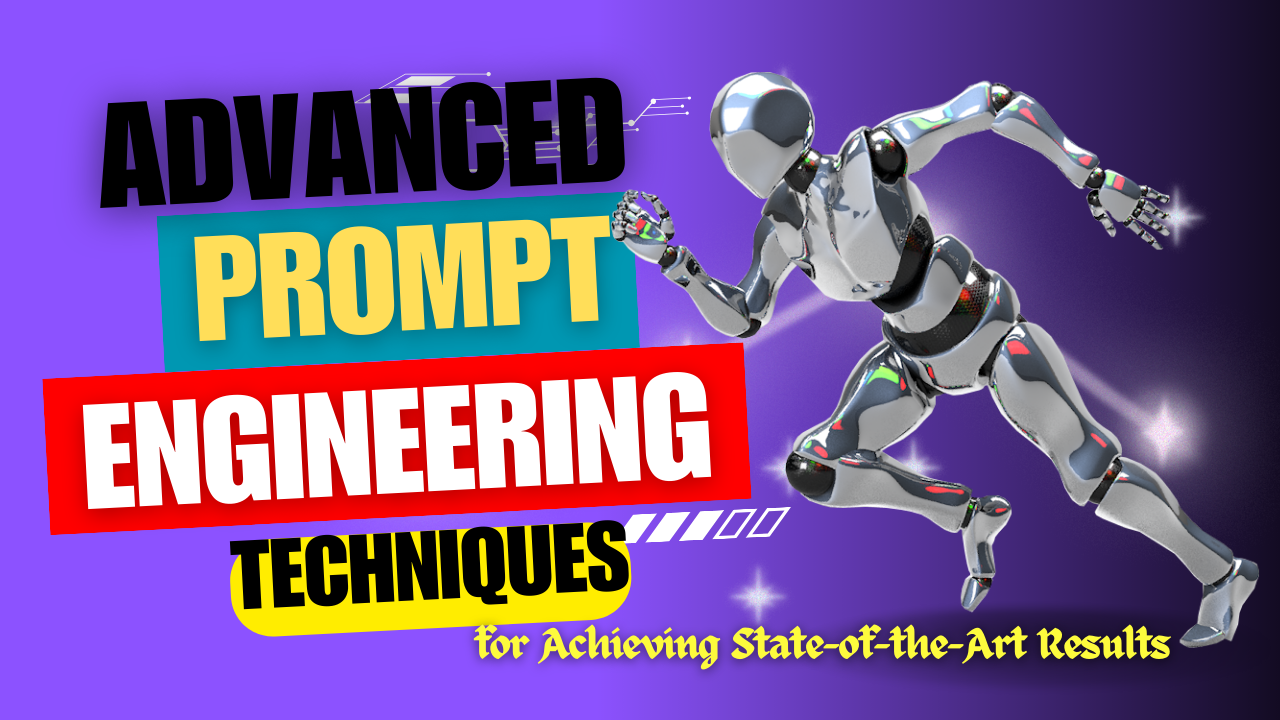Introduction: Advanced Prompt Engineering Techniques
In the ever-evolving field of natural language processing (NLP), achieving state-of-the-art results often hinges on the art of prompt engineering. This critical component of NLP involves crafting precise, context-rich inputs, or "prompts," to guide language models in generating desired outputs. In this blog post, we will delve deep into the world of advanced prompt engineering techniques that can elevate your NLP projects to new heights.
The Power of Prompts
Prompts act as bridges between human input and machine understanding. They serve as guiding signals, instructing language models on the context, style, and intention of the desired response. As NLP models like ChatGPT continue to grow in complexity and capability, mastering the art of prompt engineering becomes increasingly crucial.
Section 1: Understanding the Fundamentals Advanced Prompt Engineering Techniques
Before we dive into the advanced techniques, let's lay the groundwork by understanding the fundamentals of prompt engineering.
What Is Prompt Engineering?
At its core, prompt engineering involves designing inputs or queries that trigger specific responses from language models. It's the magic behind asking a model like ChatGPT to provide a creative short story, translate text, answer questions, or even write code.
Why Does It Matter?
The choice of prompt can significantly influence the quality and relevance of model responses. Effective prompt engineering can make the difference between a vague, unhelpful answer and a precise, informative one. It empowers users to harness the full potential of NLP models for various tasks.
Challenges and Limitations
While prompts are powerful tools, they come with their own set of challenges. Understanding these challenges is the first step toward mastering prompt engineering.
One common challenge is achieving the right balance of specificity and generality in prompts. Overly specific prompts can lead to narrow responses, while overly generic prompts may produce vague or irrelevant results. Striking this balance is key.
Another challenge is the potential for model biases. Prompts that contain biased language or assumptions can result in biased responses. It's essential to be aware of these biases and take steps to mitigate them.
In the following sections, we'll explore how to craft effective prompts, optimize them for performance, leverage prompt variations, and employ advanced tools to enhance your prompt engineering skills.
Stay with us as we uncover the secrets of mastering prompt engineering for NLP excellence.
Section 2: Crafting Effective Prompts Advanced Prompt Engineering Techniques
Effective prompts are the cornerstone of successful prompt engineering. In this section, we'll delve into the characteristics of well-crafted prompts and provide examples to illustrate their impact on language models.
Characteristics of Well-Crafted Prompts
A well-crafted prompt possesses several key characteristics that optimize its effectiveness:
1. Clarity and Specificity
Precision is paramount. A clear and specific prompt leaves no room for ambiguity, guiding the model toward generating accurate and relevant responses. For instance, instead of a vague query like "Translate this," a more effective prompt would be "Translate the following English sentence into French: 'The quick brown fox.'"
2. Contextual Information
Providing context within the prompt can drastically improve model performance. Include relevant details that help the model understand the task or intention behind the request. For instance, when asking for a summary of a news article, you can provide the article's headline, publication date, and a brief overview.
3. Desired Output Format
Specify the format you expect the response to take. If you want a model to provide a list of pros and cons for a given topic, make it explicit in the prompt. This ensures that the model's response aligns with your expectations.
Examples of Effective Prompts
Let's examine a few examples to showcase the difference that well-crafted prompts can make:
Example 1: Text Summarization
Ineffective Prompt: "Summarize the article."
Effective Prompt: "Please provide a concise summary of the following article: 'How AI Is Revolutionizing Healthcare' published on September 15, 2023, by John Smith."
The effective prompt provides specific details, ensuring the model understands which article to summarize and how to structure the summary.
Example 2: Code Generation
Ineffective Prompt: "Write a Python program to calculate Fibonacci numbers."
Effective Prompt: "Generate a Python program that calculates the first 20 Fibonacci numbers and prints the result."
The effective prompt not only specifies the programming language but also defines the task and desired output.
By mastering the art of crafting prompts with these characteristics, you can significantly enhance the performance and relevance of your NLP models.
Section 3: Strategies for Optimizing Prompts: Advanced Prompt Engineering Techniques
Optimizing prompts goes beyond their initial creation. It involves refining and fine-tuning them to achieve the best possible results from language models like ChatGPT. In this section, we'll explore various strategies for prompt optimization.
1. Iterative Testing
Effective prompt optimization often involves an iterative process. Start with a basic prompt and gradually refine it based on model responses. Experiment with different wording, structures, or additional context until you achieve the desired output. Don't be afraid to test and adjust multiple times.
2. Prompt Length
The length of your prompt matters. While being specific is important, overly lengthy prompts may overwhelm the model or lead to incomplete responses. Strive for a balance between clarity and brevity. If necessary, you can provide additional context in subsequent interactions with the model.
3. Structured Prompts
Consider structuring your prompts to guide the model's response. For instance, use bullet points or numbered lists to request organized information. Structured prompts can help the model generate well-organized outputs, such as product reviews, step-by-step instructions, or outlines.
4. Task-Specific Language
Tailor your prompts to the specific task at hand. If you're asking the model to write a poem, use poetic language in the prompt. For coding tasks, use programming terminology. Aligning the prompt's language with the task can enhance the relevance of the generated content.
5. Fine-Tuning
In some cases, fine-tuning a language model on a specific dataset or task can lead to better prompt understanding and more accurate responses. While fine-tuning requires technical expertise, it can be a powerful tool for achieving exceptional results in specialized applications.
6. Variations and A/B Testing
Experiment with prompt variations and conduct A/B testing to identify which prompts yield the best outcomes. Sometimes, a slight tweak in wording or structure can make a significant difference in model performance.
7. Addressing Biases
Be vigilant about potential biases in prompts and model responses. Avoid using biased language or assumptions in your prompts, as this can lead to biased results. Review and revise prompts to ensure fairness and inclusivity.
By implementing these strategies, you can fine-tune your prompts to optimize model performance and achieve state-of-the-art results. Prompt optimization is a dynamic process that evolves as language models advance, so stay open to ongoing experimentation and refinement.
Section 4: Real-World Applications of Prompt Engineering
Prompt engineering plays a pivotal role in various real-world applications, transforming how we interact with language models like ChatGPT. In this section, we'll explore some practical use cases where effective prompts are the linchpin for success.
1. Content Generation
One of the most common applications of ChatGPT is content generation. Whether you need blog post ideas, product descriptions, or creative stories, well-crafted prompts can be your creative muse. By providing clear instructions and context in your prompts, you can guide the model to generate content that meets your specific needs.
2. Customer Support
Chatbots powered by ChatGPT are increasingly used for customer support. In this scenario, prompts are vital for ensuring accurate and helpful responses. Well-defined prompts can direct the model to provide solutions to customer queries, troubleshoot issues, and even escalate complex problems to human agents when necessary.
3. Programming Assistance
Developers and coders often turn to ChatGPT for programming assistance. Effective prompts can specify coding tasks, request code explanations, or seek debugging help. They can also include details like programming languages, expected output, and specific problem constraints to elicit precise responses.
4. Language Translation
Language translation tasks benefit immensely from well-structured prompts. By providing the source language, target language, and the text to be translated, you can ensure accurate and context-aware translations. This is particularly valuable for businesses expanding into global markets.
5. Academic Research
Researchers use ChatGPT for a wide range of tasks, from summarizing research papers to generating hypotheses. In academic settings, prompts can provide critical context, ensuring the model understands the specific research domain and objectives.
6. Creative Writing
For writers, prompts are a source of inspiration. You can request creative prompts for poetry, short stories, or even dialogue between characters. Crafting prompts that spark imagination is key to harnessing ChatGPT's creative potential.
7. Data Analysis
In data-driven fields, you can use prompts to request data analysis, visualizations, or insights. By specifying the dataset, variables of interest, and the type of analysis required, you can obtain valuable insights from the model.
8. Decision Support
Prompt engineering can be instrumental in decision-making. You can present a scenario and ask the model to provide pros and cons, recommendations, or predictions. This is particularly useful in business and strategic planning.
9. Language Learning
Language learners can leverage ChatGPT for practice and assistance. Prompts can be designed to request grammar corrections, vocabulary explanations, or language exercises tailored to the learner's level.
10. Accessibility
Prompts can be used to enhance the accessibility of digital content. By providing prompts with accessibility guidelines, organizations can ensure that content generated by ChatGPT is compliant with standards, making it more inclusive for all users.
These real-world applications demonstrate the versatility and potential of prompt engineering in harnessing the capabilities of ChatGPT. By mastering the art of crafting prompts for specific tasks, you can unlock new possibilities and streamline various aspects of your work.
Section 5: Tools and Resources for Advanced Prompt Engineering Techniques
Efficient prompt engineering often involves utilizing the right tools and resources. In this section, we'll explore a range of tools and platforms that can assist you in creating, optimizing, and fine-tuning prompts for ChatGPT and similar language models.
1. OpenAI GPT-3 Playground
The OpenAI GPT-3 Playground is an interactive platform where you can experiment with ChatGPT. It allows you to test prompts in real-time and observe model responses. This tool is invaluable for prompt development and refinement.
2. ChatGPT API
The ChatGPT API provides programmatic access to ChatGPT, allowing you to integrate it into your applications, websites, or chatbots. You can create prompts dynamically and receive responses in real-time.
3. Prompt Libraries
Various prompt libraries and collections are available online. These resources offer pre-designed prompts for specific tasks, which can serve as inspiration or templates for your own prompts. Examples include repositories on GitHub and community-driven prompt databases.
4. Natural Language Processing (NLP) Tools
NLP libraries like spaCy, NLTK, and Hugging Face Transformers provide functionalities for text preprocessing, including tokenization and part-of-speech tagging. These tools can help you refine prompts for better model understanding.
5. Fine-Tuning Frameworks
If you require highly specialized responses, you can explore fine-tuning frameworks provided by OpenAI. Fine-tuning allows you to train a base model on custom datasets, making it more proficient in specific domains or tasks.
6. Prompt Generators
Some websites and applications offer prompt generation services. They can automatically generate prompts based on your input parameters, making it easier to create structured prompts for various tasks.
7. AI Ethics Guidelines
When crafting prompts, especially for public-facing applications, consult AI ethics guidelines. Organizations like OpenAI provide ethical considerations and best practices to ensure responsible and unbiased interactions with AI models.
8. Community Forums
Engage with AI and ChatGPT communities online. Platforms like Reddit, Stack Overflow, and AI-focused forums often have discussions and shared insights on effective prompt engineering techniques.
9. Text Editors and IDEs
Text editors and integrated development environments (IDEs) are essential for writing and organizing prompts. They offer features like syntax highlighting and code completion that can streamline prompt creation.
10. Documentation and Tutorials
Utilize documentation and tutorials provided by OpenAI and other organizations. These resources offer guidance on prompt formatting, best practices, and real-world use cases.
11. Model-Specific Guidelines
For fine-tuned models or specific applications, refer to model-specific guidelines if available. These guidelines can provide insights into optimal prompt design and usage.
As prompt engineering continues to evolve, staying informed about the latest tools and resources is essential. Depending on your project's requirements, you may choose a combination of these tools and adapt your approach accordingly.
Section 6: Common Pitfalls to Avoid in Advanced Prompt Engineering Techniques
While prompt engineering can be a powerful tool for achieving remarkable results with language models like ChatGPT, it's important to be aware of common pitfalls and challenges. In this section, we'll highlight some of these pitfalls and provide guidance on how to avoid them.
1. Ambiguity in Prompts
Pitfall: Vague or ambiguous prompts can lead to unexpected or irrelevant model responses. When prompts are unclear, the model may struggle to generate meaningful output.
Solution: Craft prompts that are precise and unambiguous. Clearly specify the desired task or context to guide the model effectively.
2. Overly Long Prompts
Pitfall: Extremely long prompts can exceed the model's token limit, resulting in incomplete or truncated responses.
Solution: Keep prompts concise and within the token limit of the model you're using. If necessary, break longer prompts into multiple interactions.
3. Biased Prompts
Pitfall: Biased language or instructions in prompts can lead to biased model responses, reinforcing stereotypes or discriminatory content.
Solution: Review and assess your prompts for potential biases. Follow ethical AI guidelines and use inclusive language.
4. Lack of Context
Pitfall: Providing insufficient context in prompts can confuse the model, making it challenging to generate coherent responses.
Solution: Include context and relevant information in your prompts to help the model understand the task or query.
5. Relying Solely on Defaults
Pitfall: Depending solely on default or pre-written prompts may limit the creativity and specificity of model responses.
Solution: Customize prompts to suit your specific needs. Experiment with different prompt styles to achieve desired outcomes.
6. Not Iterating and Testing
Pitfall: Failing to iterate and test prompts can lead to missed opportunities for improvement.
Solution: Continuously iterate on prompts and assess their effectiveness. A/B testing and user feedback can be valuable in refining prompts.
7. Ignoring Model Behavior
Pitfall: Not monitoring and addressing undesirable model behavior can result in inappropriate or harmful responses.
Solution: Regularly review model responses and establish content moderation procedures to filter out problematic outputs.
8. Neglecting User Input
Pitfall: Ignoring user input or feedback when designing prompts can lead to a disconnect between user expectations and model responses.
Solution: Actively incorporate user input and feedback to enhance prompt design and user experience.
9. Over-Reliance on Prompt Engineering
Pitfall: Assuming that prompt engineering alone can compensate for model limitations may lead to suboptimal results.
Solution: Acknowledge model limitations and explore complementary techniques such as fine-tuning or post-processing.
10. Failing to Stay Informed
Pitfall: Prompt engineering is an evolving field. Failing to stay informed about the latest research and guidelines can hinder progress.
Solution: Keep up to date with AI advancements, best practices, and ethical considerations in prompt design.
By being mindful of these common pitfalls and implementing the suggested solutions, you can navigate the complexities of prompt engineering more effectively and achieve better results with ChatGPT and similar language models.
Conclusion: Advanced Prompt Engineering Techniques
In this extensive guide, we've explored the world of prompt engineering and how it can be harnessed to achieve state-of-the-art results with language models like ChatGPT. Here are the key takeaways:
The Power of Prompts: Carefully crafted prompts act as instructions to guide language models in generating desired responses.
Understanding Language Models: Familiarize yourself with the capabilities and limitations of the language model you're using, whether it's ChatGPT or any other variant.
Crafting Effective Prompts: Create prompts that are clear, concise, and unambiguous. Specify the task or context to guide the model effectively.
Leveraging Prompt Templates: Utilize prompt templates to streamline the prompt creation process and ensure consistency.
Testing and Iterating: Continuously test and iterate on prompts to optimize model responses. A/B testing and user feedback are valuable resources.
Real-World Applications: Explore various real-world applications of prompt engineering, from content generation to problem-solving.
Tools and Resources: Discover valuable tools and resources that can aid in prompt generation and model interaction.
Common Pitfalls: Be aware of common pitfalls in prompt design, including ambiguity, bias, and overly long prompts. Mitigate these issues to improve results.
Ethical Considerations: Follow ethical AI guidelines, avoid biased prompts, and monitor model behavior to ensure responsible AI use.
Continuous Learning: Stay informed about the latest developments in prompt engineering and AI research to remain at the forefront of this evolving field.
By mastering prompt engineering, you can unlock the full potential of language models and use them effectively in a wide range of applications. Whether you're a content creator, developer, or researcher, the insights and techniques shared in this guide can empower you to achieve state-of-the-art results in natural language processing.
Thank you for embarking on this journey through the world of prompt engineering. If you have any questions or need further assistance, please don't hesitate to reach out. Good luck with your prompt engineering endeavors!
(FAQs) : Advanced Prompt Engineering Techniques
Q1: What is prompt engineering, and why is it important?
A1: Prompt engineering involves designing clear and effective instructions (prompts) to guide language models in generating desired responses. It's crucial because well-crafted prompts significantly influence the quality of output from these models. They can make complex tasks more accessible and ensure ethical and useful AI interactions.
Q2: How do I choose the right language model for my project?
A2: Selecting the right language model depends on your project's requirements. Consider factors like model size, capabilities, and the specific task you want to accomplish. For more general tasks, models like ChatGPT are versatile, while more specialized models may be needed for niche applications.
Q3: What are some best practices for crafting effective prompts?
A3: Crafting effective prompts involves being clear, concise, and specific. Specify the task or context, use relevant keywords, and avoid ambiguity. It's also essential to understand the model's strengths and limitations to create prompts that align with its capabilities.
Q4: How can I test and iterate on prompts for better results?
A4: Testing and iteration are key to optimizing prompts. Conduct A/B testing to compare different prompts' performance. Solicit user feedback and use it to refine your prompts. Continuous improvement is essential for achieving better outcomes.
Q5: What are common pitfalls to avoid in prompt engineering?
A5: Common pitfalls include vague or ambiguous prompts, biased language, and overly long prompts. Avoiding these issues requires careful design and monitoring of prompts. Additionally, consider ethical considerations to ensure responsible AI use.
Q6: Are there any tools and resources available for prompt engineering?
A6: Yes, there are several tools and resources that can aid in prompt engineering. These include prompt template libraries, prompt generators, and AI research papers. Staying updated with the latest AI research is also valuable.
Q7: How can I use prompt engineering for content creation?
A7: Prompt engineering can be used to generate content ideas, outlines, or even full articles. By providing a clear prompt, you can instruct the language model to assist you in generating content for various topics and niches.
Q8: How do I ensure ethical AI usage in prompt engineering?
A8: To ensure ethical AI usage, avoid prompts that encourage harmful or biased content. Monitor model behavior and be prepared to intervene if the model generates inappropriate responses. Staying informed about AI ethics guidelines is essential.
Q9: Can I use prompt engineering for creative writing or storytelling?
A9: Absolutely! Prompt engineering can be a valuable tool for creative writing and storytelling. You can create prompts that inspire the model to generate plot ideas, character descriptions, or even entire narratives.
Q10: Where can I find more resources and examples of effective prompts?
A10: Online AI communities, forums, and AI research papers are excellent sources for finding more resources and examples of effective prompts. You can also explore prompt template libraries and AI-focused websites for inspiration.
Feel free to ask if you have more specific questions or if there's anything else you'd like to know about prompt engineering and using language models effectively.
Written by: Md Muktar Hossain
























